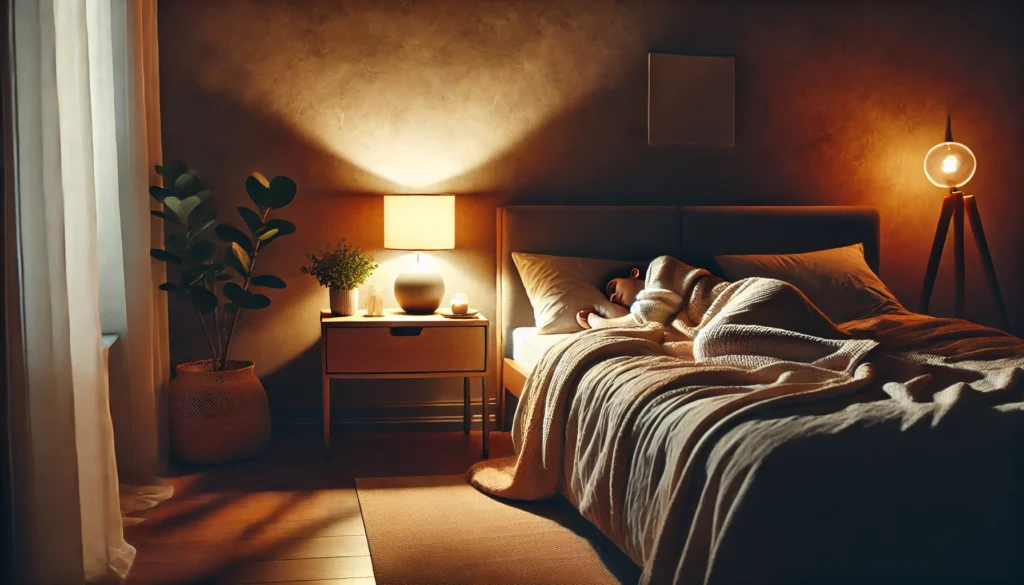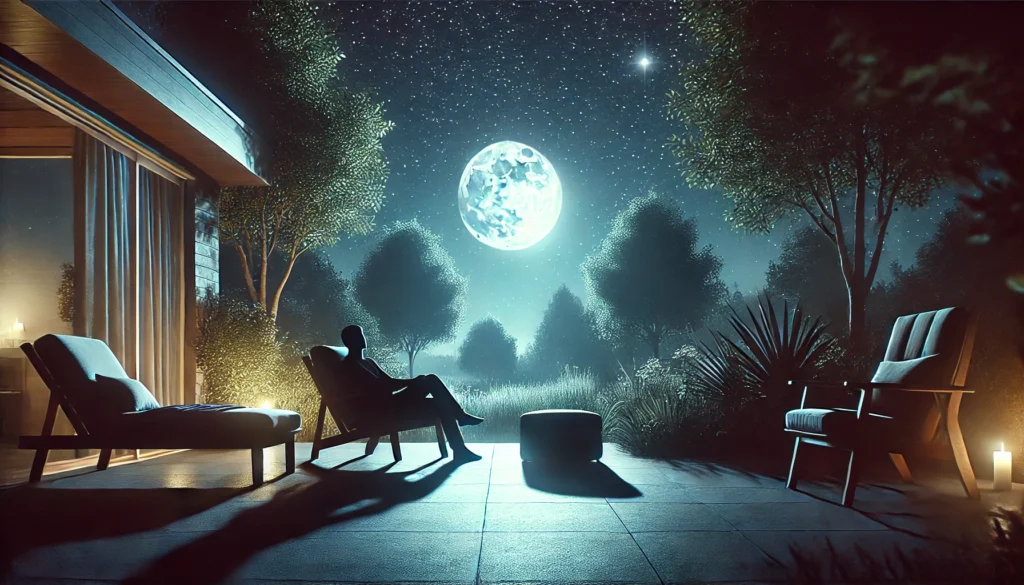Have you ever experienced a sudden jolt or sinking feeling just as you’re drifting off to sleep? This sensation, often described as a feeling of falling, can be startling and even unsettling.
Known as a hypnic jerk or sleep start, this phenomenon is quite common. Yet, many people are left wondering why it happens and what it means.
In this article, we’ll delve into the science behind this intriguing sleep phenomenon. We’ll explore what hypnic jerks are and the theories that attempt to explain why we experience them.
We’ll also look at the factors that may trigger this sinking sensation. From lifestyle and environmental influences to the role of stress and anxiety, we’ll examine how these elements can impact your sleep experience.
Moreover, we’ll provide practical advice on managing and reducing the sinking feeling. This includes sleep hygiene tips for a better night’s rest and guidance on when to consult a healthcare provider.
For the biohackers among us, we’ll discuss sleep optimization and the role of nootropics and supplements. Finally, we’ll touch on the cultural and historical views on the falling sensation during sleep.
Join us as we unravel the mystery of the sinking feeling at sleep. Whether you’re a health and wellness coach, a science journalist, or a biohacker, this comprehensive guide is designed to enlighten and inform.
You May Also Like: Sleep Hygiene: Key Practices for Health
The Science Behind the Sinking Feeling
Hypnic jerks occur at the threshold between wakefulness and sleep. This transition phase is known as Stage 1 sleep.
It is the lightest stage of sleep, where the body begins to relax, and brain activity slows. During this time, our muscle tone decreases, which can result in involuntary muscle contractions. These contractions are known as hypnic jerks.
The physiology of hypnic jerks is linked to myoclonus—sudden, brief muscle twitches. Myoclonus is common in daily life, like the hiccups or the twitch of an eyelid.
Experts agree that hypnic jerks are generally benign and not a sign of a serious health issue. They typically occur once in a night or infrequently.
The sensation can range from mild to strong. It might be accompanied by a dream or the perception of falling, adding to its unsettling nature.
Understanding the scientific basis of this sensation can alleviate concerns. It highlights the normalcy of these experiences as part of human sleep behavior.
What Are Hypnic Jerks?
Hypnic jerks are involuntary muscle movements happening at the start of sleep. They are often sudden, causing a brief but notable awakening.
These jerks are characterized by a sharp twitch that can involve any muscle group. Typically, they occur in the arms or legs, causing a brief sensation of falling.
To better understand hypnic jerks, it’s helpful to grasp some key points:
- Definition: Involuntary muscle twitch at sleep onset.
- Frequency: Commonly experienced but variable in occurrence.
- Associated Sensations: Often feels like falling.
- Impact: Usually harmless but can be startling.
- Occasionally Linked With: Dream-like visuals or sounds.
Despite their abruptness, hypnic jerks are generally considered normal. They reflect the body’s natural shift from wakefulness to the early stages of sleep.
Most people experience hypnic jerks at least once in their lifetime. In fact, their ubiquity is evidence of their role in the sleep process.
Theories Explaining Why We Experience This Phenomenon
Though widely experienced, the exact cause of hypnic jerks remains a subject of study. Various theories seek to explain their occurrence.
One prevailing hypothesis is that hypnic jerks are a natural part of the nervous system’s transition into sleep. As the brain relaxes, miscommunications can lead to muscle twitches.
Another theory suggests that these jerks are a primitive reflex. The brain misreads the muscle relaxation as a threat of falling, prompting a muscle contraction.
Stress, anxiety, and fatigue can exacerbate the frequency of hypnic jerks. These factors enhance the likelihood of nervous system misfires as sleep onset nears.
Furthermore, some researchers think that the overuse of stimulants like caffeine makes these sensations more common. Such substances keep the nervous system on alert, delaying the relaxation phase of sleep.
Despite ongoing research, hypnic jerks remain an area rich with questions. However, these theories give insight into how our body’s natural processes can sometimes lead to unexpected reactions.

Factors That May Trigger the Sinking Sensation
Several factors can increase the frequency of the sinking feeling when falling asleep. These factors often intertwine and contribute to how often we experience hypnic jerks.
A variety of lifestyle choices and environmental conditions play a role in this phenomenon. Understanding and modifying these can reduce the occurrence of sudden falling sensations.
Some key factors to consider include:
- Stimulants: Consumption of caffeine or nicotine near bedtime.
- Exercise: Engaging in vigorous physical activity late in the evening.
- Stress Levels: Day-to-day stress and anxiety levels.
- Sleep Schedule: Irregular sleep patterns or insufficient sleep.
- Electronic Use: Exposure to screens before bedtime.
The interplay of these factors can disrupt the body’s transition into sleep. Heightened nervous system activity may make hypnic jerks more frequent.
By addressing these contributors, individuals can mitigate these triggers. Creating an environment conducive to restful sleep can be highly effective.
Lifestyle and Environmental Influences
Daily habits greatly affect the sinking feeling when falling asleep. The environment plays an equally important role in sleep quality.
Using stimulants, such as caffeine, close to sleep time, keeps the brain active. This can hinder the natural relaxation the body needs for sleep onset.
Evening workouts, especially intense ones, elevate heart rate and metabolism. This elevated state can delay the body’s switch into the relaxed state necessary for sleep.
Having a stable sleep schedule promotes consistency in the body’s internal clock. Irregular patterns can confuse the body, increasing the chances of a hypnic jerk.
The Role of Stress and Anxiety
Stress and anxiety can significantly impact sleep and its transitions. When the mind is active, it can prevent full relaxation, the main aim of pre-sleep rituals.
An active mind might prevent the full transition into sleep. Stress may lead to irregular breathing and muscle tension, heightening chances for hypnic jerks.
Managing stress involves relaxation techniques that calm the mind and body. Practices such as mindfulness, meditation, or gentle yoga before sleep can be beneficial.
Learning to process daily stress can also aid in reducing nighttime disturbances. Addressing anxiety and stress during the day helps pave the way for better sleep at night.
Managing and Reducing the Sinking Feeling
Reducing the frequency of hypnic jerks is achievable through practical strategies. Understanding the underlying causes helps in managing this unsettling sensation.
Regular sleep patterns are foundational to minimizing sleep disturbances. Consistency trains your body’s natural clock, making sleep transitions smoother.
Stress management techniques can mitigate anxiety-related sleep disturbances. Activities promoting relaxation, such as meditation, help ease the mind before bed.
Improving overall sleep hygiene is another effective approach. A conducive sleep environment enhances relaxation and helps ward off hypnic jerks.
Here are practical steps to reduce the occurrence:
- Consistent Schedule: Stick to regular sleeping and waking times.
- Limit Stimulants: Avoid caffeine and nicotine in the evenings.
- Create Ambiance: Use dim lighting and reduce noise.
- Mindful Unwind: Engage in calming activities, like gentle yoga.
- Breathing Exercises: Practice slow, deep breathing before sleep.
By implementing these techniques, one can create a harmonious path to sleep. Small changes in lifestyle can have a profound impact.
Sleep Hygiene Tips for a Better Night’s Rest
Good sleep hygiene is essential for quality rest. Establishing a bedtime routine can drastically improve sleep quality and reduce sudden jerks.
Creating the right environment is also vital. A comfortable mattress and room temperature can promote a restful atmosphere.
Limiting screen time helps calm the mind before bed. Blue light from devices disrupts melatonin production, delaying sleep onset.
To optimize sleep, consider these tips:
- Dim Lighting: Prepare your body for sleep by dimming lights.
- Avoid Screens: Cease device use an hour before bed.
- Comfort First: Ensure your bed and pillows support your posture.
- Wind Down: Develop a pre-sleep routine that includes reading or bathing.
- Mindful Meditation: Engage in brief meditation to clear the mind.
Prioritizing these habits can help smooth the transition from wakefulness to sleep. Simple actions lead to a noticeable decline in sleep-related issues.
When to Consult a Healthcare Provider
While hypnic jerks are usually harmless, frequent occurrences may warrant professional attention. If they significantly disrupt sleep, consider seeking advice.
Persistent or severe cases might indicate another sleep disorder. Differentiating between normal hypnic jerks and conditions like restless leg syndrome is crucial.
Consult a healthcare provider if anxiety or insomnia persists. Medical evaluation may uncover underlying health issues affecting sleep.
Don’t hesitate to seek help if these sensations affect your daily life. Professional guidance can ensure that appropriate measures are taken. Identifying and addressing concerns early can prevent long-term sleep disruptions.

The Biohacker’s Perspective on Sleep Optimization
Biohackers view sleep as a vital component of mental and physical optimization. Improving sleep means enhancing overall well-being and performance.
Attention to detail is key in biohacking sleep patterns. Understanding personal sleep cycles can help in crafting effective sleep strategies.
Technology plays a significant role for biohackers. Devices like sleep trackers provide valuable insights into sleep quality and disturbances.
Biohackers often approach sleep optimization with a willingness to experiment. Utilizing data-driven techniques helps refine individual sleep protocols for better outcomes.
Tracking and Improving Sleep Patterns
Tracking sleep patterns allows biohackers to personalize their approach. Devices monitor sleep stages and detect irregularities, providing actionable information.
Understanding sleep cycles aids in identifying problems such as hypnic jerks. This data helps in implementing targeted improvements.
Regularly reviewing sleep data leads to informed adjustments. These adjustments can include altering sleep schedules or changing pre-sleep routines.
By continuously refining their sleep strategy, biohackers aim to maximize efficiency and quality of rest. The goal is to enhance both mental sharpness and physical stamina.
Nootropics and Supplements for Sleep
Biohackers often explore nootropics to enhance sleep quality. These supplements can support relaxation and ease the transition into sleep.
Some nootropics target neurotransmitter pathways, promoting a calming effect. They may help mitigate factors causing hypnic jerks.
Magnesium, for instance, is known for its calming properties. Adaptogens like ashwagandha can also aid in reducing stress and improving sleep.
Exploring these options requires careful consideration and research. Understanding their effects ensures safe and effective use.
Biohackers aim to leverage these supplements to optimize their restorative sleep and, ultimately, their daily performance.
Cultural and Historical Views on the Falling Sensation
The experience of feeling a falling sensation at sleep has fascinated cultures throughout history. Many societies have crafted unique interpretations.
Some view this sensation with mystical significance. For example, it often features in religious and spiritual contexts as omens or divine communications.
Art and literature frequently explore these themes. They reflect societal beliefs and provide insight into how different cultures perceive sleep phenomena.
Interestingly, varying interpretations often share common threads. Despite differences, they all illustrate the universal curiosity and intrigue surrounding sleep experiences.
Myths and Folklore Associated with Sleep
Folklore is rich with tales of the nocturnal falling sensation. Many myths offer explanations that blend fantasy with the subconscious mind’s mysteries.
In some cultures, it’s believed that spirits or entities interact with humans during sleep. This interaction sometimes explains the sensation of falling.
Other stories suggest a connection with out-of-body experiences or travels. These narratives reflect human curiosity about the soul’s journey during rest.
Such stories serve multiple roles. They entertain, educate, and explore complex relationships between human consciousness and the metaphysical realm.
Despite modern scientific understanding, these myths remain potent. They underscore the timeless allure of sleep’s mysterious and enchanting nature.

Conclusion and Key Takeaways
Understanding the sinking feeling when falling asleep can offer peace of mind. This sensation, while unsettling, is generally harmless.
Embracing informed approaches fosters better sleep experiences. Awareness and practical strategies can mitigate sleep disturbances.
Encouraging Holistic Sleep Health
Prioritizing holistic sleep health benefits both body and mind. Techniques like stress reduction and sleep hygiene are key.
Exploring a well-rounded approach enhances not just sleep, but overall well-being. It empowers individuals to take control of their health.
Final Thoughts for Health and Wellness Coaches, Science Journalists, and Biohackers
Health and wellness coaches can utilize this knowledge to support clients. Providing clear, actionable advice is crucial for effective coaching.
Science journalists can demystify the topic for the public. Presenting engaging stories about sleep science makes complex information accessible.
Biohackers have the tools to optimize their sleep. By integrating this knowledge, they can enhance both physical and cognitive performance.
Further Reading:
Cleveland Clinic: Why Do I Feel Like I’m Falling or Twitching As I’m Falling Asleep?
Sleep Foundation: Sleep Paralysis: Symptoms, Causes, and Treatment
Dawn: Why You Feel Strange Sensations When You Fall Asleep (Falling Sensation, Tingling, Jerking)
Important Note: The information contained in this article is for general informational purposes only, and should not be construed as health or medical advice, nor is it intended to diagnose, prevent, treat, or cure any disease or health condition. Before embarking on any diet, fitness regimen, or program of nutritional supplementation, it is advisable to consult your healthcare professional in order to determine its safety and probable efficacy in terms of your individual state of health.
Regarding Nutritional Supplements Or Other Non-Prescription Health Products: If any nutritional supplements or other non-prescription health products are mentioned in the foregoing article, any claims or statements made about them have not been evaluated by the U.S. Food and Drug Administration, and such nutritional supplements or other health products are not intended to diagnose, treat, cure, or prevent any disease.


